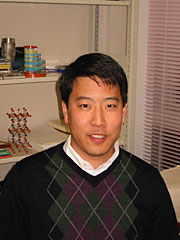- Number 331 |
- February 21, 2011
New Materials for Electronics, Energy: A Science of Control
Basic research into the properties of materials covers a variety of highly technical subjects, such as high-temperature superconductivity, quantum effects, spintronics and catalytic behaviors. All these areas of research boil down to one thing: control.
Harold Hwang of the Stanford Institute of Materials and Energy Sciences, a joint SLAC-Stanford institute, may not be master of matter—yet—but he's learning to be very persuasive. Hwang researches complex oxides: materials that share similar crystal structures, but exhibit a broad range of properties. Complex oxides can act as insulators, semiconductors, metals and superconductors, to name only a few possibilities.
Hwang and his group focus on fabricating crystals from extremely thin layers of these oxides—crystals which might then be persuaded to retain the properties of the individual oxide or take on new properties resulting from the interactions between the oxide layers. These layers are known as thin films and are vital to the semiconductor industry.
"I'd like to funnel the research into something that would eventually show up in your camera or computer," Hwang said. "Compared to semiconductors, the additional complexity of the materials we're studying gives a much richer base of physical properties." These properties all appear in a common family of materials that fit nicely on top of each other—materials which, thanks to their common crystalline structure, lend themselves to layering.
"If everything works wonderfully," he continued, "I can give you any flavor or ingredient and we can imagine stacking them together." Hwang's research involves depositing layers of oxide that are mere atoms thick, yet remain remarkably stable.
"This really allows you to create new crystal structures," Hwang said. "The challenge going forward is to understand the design principles so we can engineer new materials for electronics, sensing and energy applications."Submitted by DOE's SLAC National Accelerator Facility

